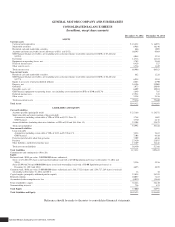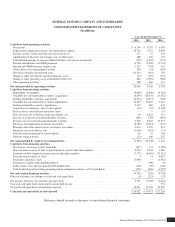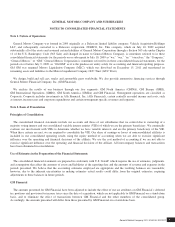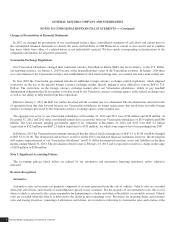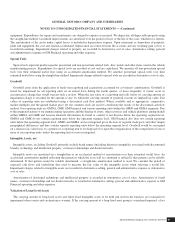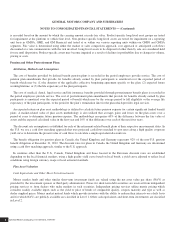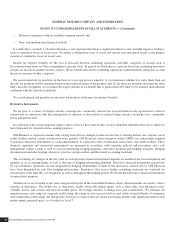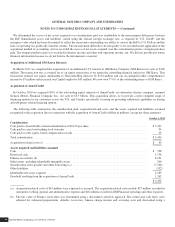General Motors 2012 Annual Report Download - page 85
Download and view the complete annual report
Please find page 85 of the 2012 General Motors annual report below. You can navigate through the pages in the report by either clicking on the pages listed below, or by using the keyword search tool below to find specific information within the annual report.
GENERAL MOTORS COMPANY AND SUBSIDIARIES
NOTES TO CONSOLIDATED FINANCIAL STATEMENTS — (Continued)
is recorded based on the amount by which the carrying amount exceeds fair value. Product-specific long-lived asset groups are tested
for impairment at the platform or vehicle line level. Non-product specific long-lived assets are tested for impairment on a reporting
unit basis in GMNA, GME, and GM Financial and tested at or within our various reporting units within our GMIO and GMSA
segments. Fair value is determined using either the market or sales comparison approach, cost approach or anticipated cash flows
discounted at a rate commensurate with the risk involved. Long-lived assets to be disposed of other than by sale are considered held
for use until disposition. Product-specific assets may become impaired as a result of declines in profitability due to changes in volume,
pricing or costs.
Pension and Other Postretirement Plans
Attribution, Methods and Assumptions
The cost of benefits provided by defined benefit pension plans is recorded in the period employees provide service. The cost of
pension plan amendments that provide for benefits already earned by plan participants is amortized over the expected period of
benefit which may be: (1) the duration of the applicable collective bargaining agreement specific to the plan; (2) expected future
working lifetime; or (3) the life expectancy of the plan participants.
The cost of medical, dental, legal service and life insurance benefits provided through postretirement benefit plans is recorded in
the period employees provide service. The cost of postretirement plan amendments that provide for benefits already earned by plan
participants is amortized over the expected period of benefit which may be the average period to full eligibility or the average life
expectancy of the plan participants, or the period to the plan’s termination date for the plan which provides legal services.
An expected return on plan asset methodology is utilized to calculate future pension expense for certain significant funded benefit
plans. A market-related value of plan assets methodology is also utilized that averages gains and losses on the plan assets over a
period of years to determine future pension expense. The methodology recognizes 60% of the difference between the fair value of
assets and the expected calculated value in the first year and 10% of that difference over each of the next four years.
The discount rate assumption is established for each of the retirement-related benefit plans at their respective measurement dates. In
the U.S. we use a cash flow matching approach that uses projected cash flows matched to spot rates along a high quality corporate
yield curve to determine the present value of cash flows to calculate a single equivalent discount rate.
The benefit obligation for pension plans in Canada, the United Kingdom and Germany represents 92% of the non-U.S. pension
benefit obligation at December 31, 2012. The discount rates for plans in Canada, the United Kingdom and Germany are determined
using a cash flow matching approach, similar to the U.S. approach.
In countries other than the U.S., Canada, United Kingdom and those located in the Eurozone discount rates are established
depending on the local financial markets, using a high quality yield curve based on local bonds, a yield curve adjusted to reflect local
conditions using foreign currency swaps or local actuarial standards.
Plan Asset Valuation
Cash Equivalents and Other Short-Term Investments
Money market funds and other similar short-term investment funds are valued using the net asset value per share (NAV) as
provided by the investment sponsor or third-party administrator. Prices for short-term debt securities are received from independent
pricing services or from dealers who make markets in such securities. Independent pricing services utilize matrix pricing which
considers readily available inputs such as the yield or price of bonds of comparable quality, coupon, maturity and type as well as
dealer supplied prices. Money market mutual funds which provide investors with the ability to redeem their interests on a daily basis
and for which NAVs are publicly available are classified in Level 1. Other cash equivalents and short-term investments are classified
in Level 2.
General Motors Company 2012 ANNUAL REPORT82


